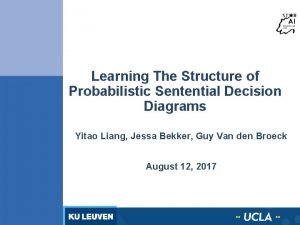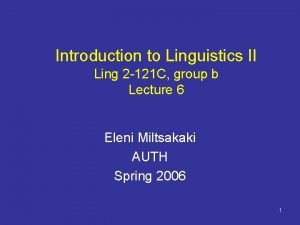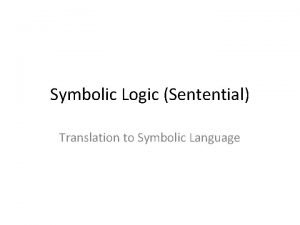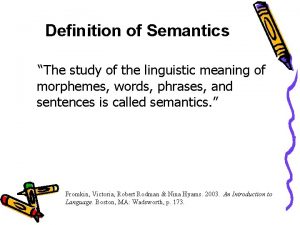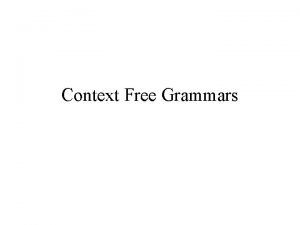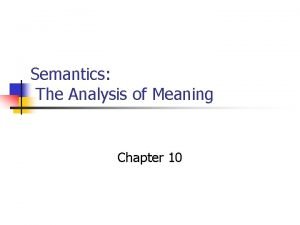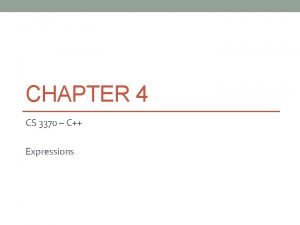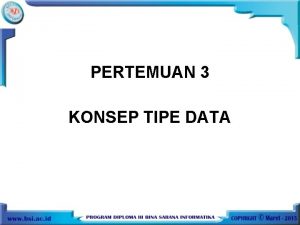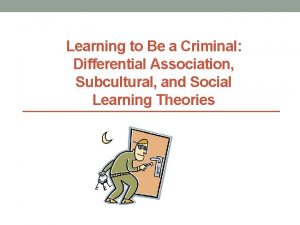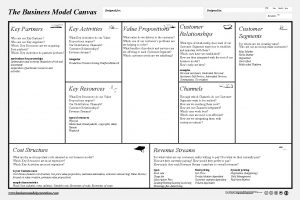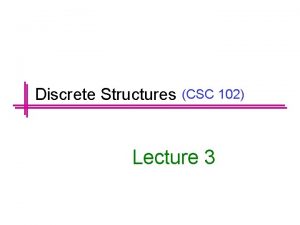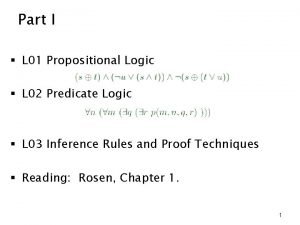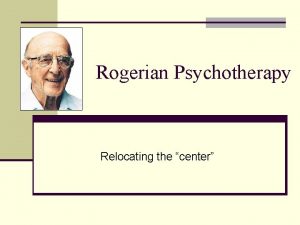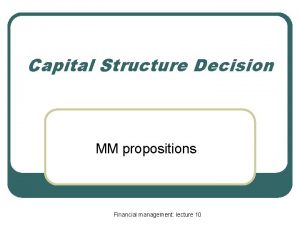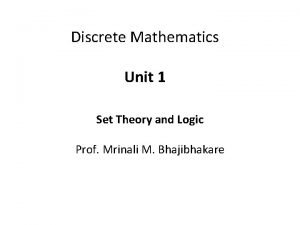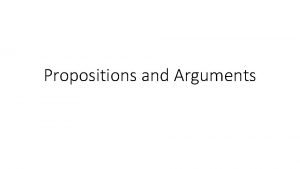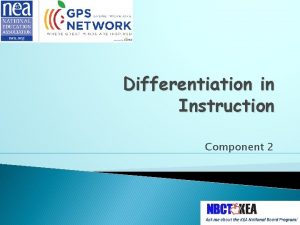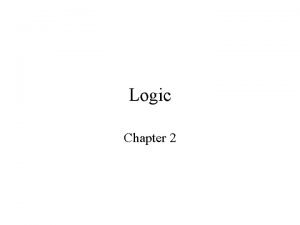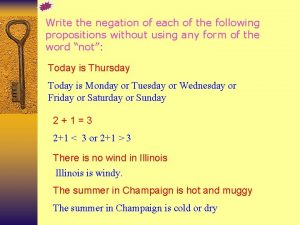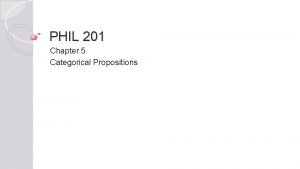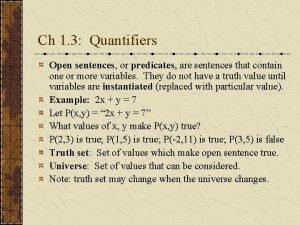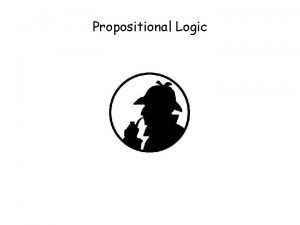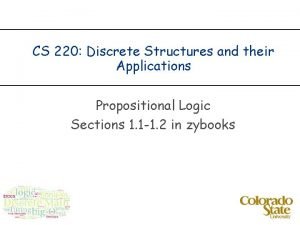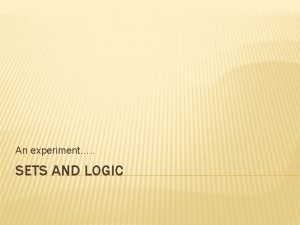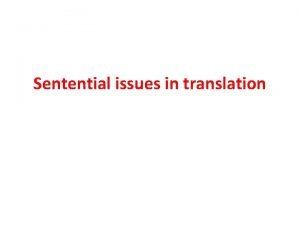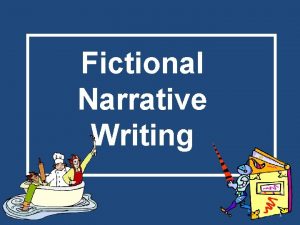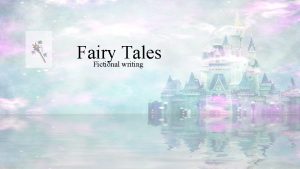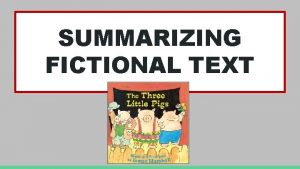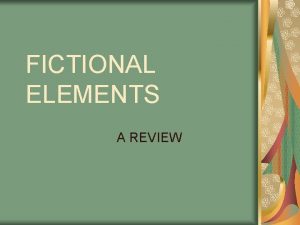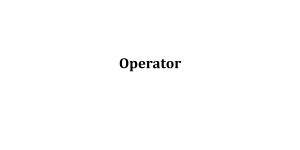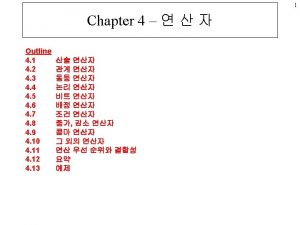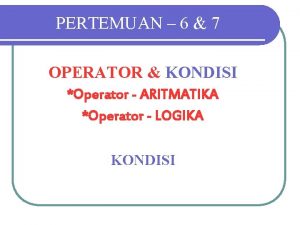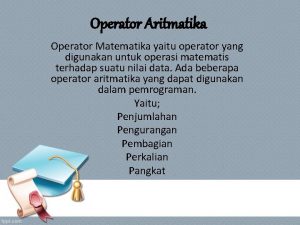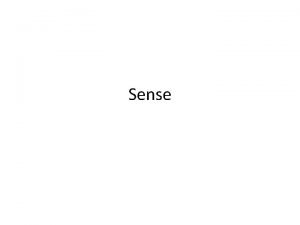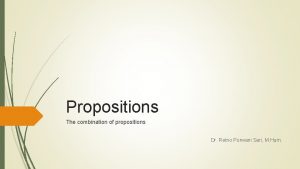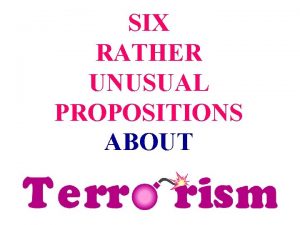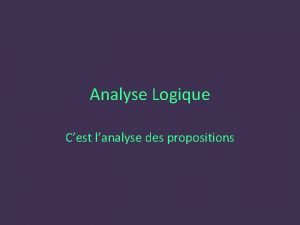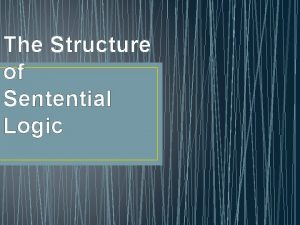FICTIONAL PROPOSITIONS A sentential operator is an expression































- Slides: 31

FICTIONAL PROPOSITIONS • A sentential operator is an expression that combines with a sentence to form a new sentence. • The resulting sentence may differ in truth-value from the original.

FICTIONAL PROPOSITIONS <unicorns, existence> Not: <unicorns, existence> <Mrs. Gamp, fondness of gin> In the fiction: <Mrs. Gamp, fondness of gin> <2, being prime> In the fiction: <2, being prime>

QUIZ 1 Why is the sentence 1. The green slime is on the loose. supposed to be philosophically more problematic than the sentence 2. In the fiction: the green slime is on the loose. ? A. It is much more frightening. B. It would have to be literally true. C. It implies that truth is objective when it isn’t. D. It can’t be literally true unless the green slime exists.

FICTIONAL PROPOSITIONS • Fictional propositions are those propositions that are true in a fiction. • Fictional worlds are collections of related fictional propositions.

FICTIONAL PROPOSITIONS IMAGINARY PROPOSITIONS

FICTIONAL PROPOSITIONS MAKE-BELIEVE PROPOSITIONS

FICTIONAL PROPOSITIONS MAKE-BELIEVE PROPOSITIONS

GAMES OF MAKE-BELIEVE • Games of make-believe generate fictional propositions. • They are made up of principles (or rules) concerning which kinds of propositions are to be counted as true in the fiction. - Whenever the asphalt is black, then it is make-believedly true that the floor is lava. - Whenever there is a glob of mud in a certain orange crate, then it is make-believedly true that there is a pie in the oven.

GAMES OF MAKE-BELIEVE • Principles of make-believe that are in force within a given game need not be explicitly formulated or deliberately adopted. • The fact that participants to a given game are disposed to non-deliberately, spontaneously imagine that certain propositions are true is typically good evidence that a given principle is in force within that game.

WALTON’S THEORY APPLIED • “Why is it so natural to describe Charles as afraid of the slime, if he is not, and how is his experience to be characterized? In what follows I shall develop a theory to answer these questions” (Walton 1978, 10).

WALTON’S THEORY APPLIED Black is checkmated. The king is in check and there is no way to get out of it. It is a rule of chess that whenever a player’s king is in check and there is no way to get out of it, then the player is checkmated. The Flash broke the law. The Flash was speeding down the highway at 458 mph. It is illegal to exceed 40 mph on Burnett Rd.

WALTON’S THEORY APPLIED In the fiction: the floor is lava. Whenever the asphalt is black, then it is true in the fiction that the floor is lava. The asphalt is black.

WALTON’S THEORY APPLIED In the fiction: the green slime is on the loose. Facts about the image on screen. Operative principles of make-believe.

QUIZ 2 1. According to Walton, the fact that Charles has quasi- fear symptoms (quickened pulse, tensed muscles, etc. ) is sufficient to make it the case that make-believedly he fears the green slime. True B. False A.

WALTON’S THEORY APPLIED In the fiction: Charles fears the green slime. Charles quasi-fear is the result of his belief that it is true in the fiction that the green slime is a real danger. Whenever one’s quasi-fear is the result of such a belief, then it is true in the fiction that one is afraid.

WALTON’S THEORY APPLIED • Janet Leigh portraying Marion Crane • Anthony Perkins portraying Norman Bates • Girl portraying a monster • Boy portraying himself • Prop on screen representing a green slime • Charles portraying himself

WALTON’S THEORY APPLIED • Charles is akin to an actor in that he is engaged in a game of make-believe. We can regard him as treating the images on screen as props. • But unlike with some actors, the make-believe truth that he is afraid partly depends on his physiological/psychological symptoms of quasi-fear. • These symptoms are the product of Charles’ belief that make-believedly the green slime is a real threat.

WALTON’S THEORY APPLIED ⊂ PUBLICLY RECOGNIZED FICTIONAL WORLDS

WALTON’S THEORY APPLIED PRIVATELY RECOGNIZED FICTIONAL WORLD

WALTON’S THEORY APPLIED ⊂ PUBLICLY RECOGNIZED FICTIONAL WORLD PRIVATELY RECOGNIZED FICTIONAL WORLDS

EVIDENCE • Charles’ participation in his game of make-believe is more or less automatic and non-deliberative. • But he might easily slip into participating in this game deliberately. - “Yikes, here it comes!” • This indicates that Charles regards the slime as headed toward him, that he himself belongs to a larger fictional world including the green slime.

EVIDENCE Black is checkmated. The king is in check and there is no way to get out of it. Whenever a player’s king is in check and there is no way to get out of it, then the player is checkmated. The Flash broke the law. The Flash was speeding down the highway at 458 mph. It is illegal to exceed the speed limit.

EVIDENCE In the fiction: Charles fears the green slime. Charles quasi-fear is the result of his belief that it is true in the fiction that the green slime is a real danger. Whenever one’s quasi-fear is the result of such a belief, then it is true in the fiction that one is afraid.

EVIDENCE In the fiction: Charles fears the green slime. Charles quasi-fear is the result of his belief that it is true in the fiction that the green slime is a real danger. Whenever one’s quasi-fear is the result of such a belief, then it is true in the fiction that one is afraid.

EVIDENCE • Charles imagines himself to be afraid of the green slime. • This imaginative act is non-deliberate and spontaneous. • But recall that a disposition to non-deliberately, spontaneously imagine that certain propositions are true is typically good evidence that a given principle is in force within a given game of make-believe. • So: we have good reason to believe that Charles recognizes a principle to the effect that his quasi-fear partly determines that it is true in the fiction that he is afraid.

OBJECTION 1) If Charles’ assertion that he is terrified really means that in the fiction he is terrified, then it should be felicitous for Charles to just say that (“I’m afraid, in the fiction!”). 2) But that isn’t felicitous. 3) So: that’s not what Charles’ claim means. QUIZ 3: What is Walton’s response to this objection? A. Charles never asserted that he is terrified in the first place. B. It is felicitous for Charles to say “I’m afraid, in the fiction!” because “I’m afraid” is merely an ellipsis for the former. C. Charles pretended to assert (seriously) that he is terrified. D. Both (A) and (C)

RESPONSE • Charles is not asserting that he is terrified at all. • He is instead pretending to assert that he is terrified. • When we later describe the situation, we may genuinely assert that Charles was terrified. • But in that context, it is not necessarily infelicitous to say it was only make-believedly true that Charles was terrified— he was simply playing along with the film.

CONNECTIONS Literally: seeing Florence. Literally: Florence is frowning. In the fiction: Florence is frowning. Florence Owens Thompson Literally: seeing a Louis-depiction. Literally: seeing Louis. In the fiction: seeing Louis XIV

FURTHER APPLICATIONS 1. Charles fears the green slime. 2. Playgoers pity Willy Loman. 3. Cinemagoers detest Nurse Ratched. 4. Fans envy Wonder Woman. Cognitive constraint: x has an emotion directed at y only if x believes that y exists.

FURTHER APPLICATIONS In the fiction: Charlotte envies Wonder Woman. Charlotte’s quasi-envy is the result of her belief that it is true in the fiction that Wonder Woman is extremely powerful. Whenever one’s quasi-envy is the result of such a belief, then it is true in the fiction that one experiences envy.

FURTHER APPLICATIONS • Puzzle of contradictory desires: a reader or viewer may want the heroine to suffer a tragic fate, and yet when interacting with the fiction, become caught up in the story and “want” her to succeed. But intuitively, this rarely involves an irrational set of inconsistent desires. How could that be? • Puzzle of repeated investment: works of fiction can be effective even after numerous readings or viewings. But how can that be, given that readers or viewers know exactly how the plot will unfold?
 Right sentential form
Right sentential form Presupposition in pragmatics
Presupposition in pragmatics Sentential decision diagrams
Sentential decision diagrams C 2 =121
C 2 =121 Symbolic logic translation examples
Symbolic logic translation examples Definition of semantics
Definition of semantics Recursive inference
Recursive inference Example of hyponym
Example of hyponym Sentential semantics
Sentential semantics Unary and binary operations
Unary and binary operations Tipe data int mempunyai ukuran
Tipe data int mempunyai ukuran Pada tipe data boolean, berlaku operator-operator...
Pada tipe data boolean, berlaku operator-operator... Prioritas operator
Prioritas operator Operation expression
Operation expression Linear term
Linear term Sutherland's nine propositions
Sutherland's nine propositions Key partners example business model canvas
Key partners example business model canvas Conditional proposition examples
Conditional proposition examples P double implies q
P double implies q Condition irréelle
Condition irréelle Carl rogers 19 propositions
Carl rogers 19 propositions Capital structure in financial management
Capital structure in financial management Idempotent law example
Idempotent law example Propositions and arguments
Propositions and arguments 5 core propositions
5 core propositions Propositions in logic
Propositions in logic What is the negation of each of these propositions
What is the negation of each of these propositions Categorical propositions
Categorical propositions Partner business propositions
Partner business propositions Define open sentence
Define open sentence Logical equivalence
Logical equivalence True proposition examples
True proposition examples


